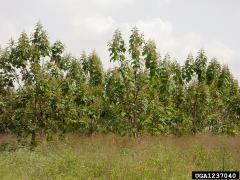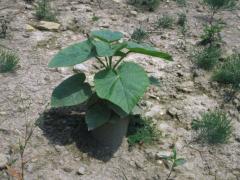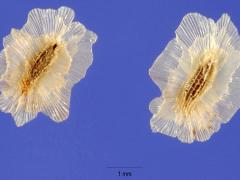Invasive Species: Paulownia tomentosa, Princess Tree
Princess tree is an invasive deciduous tree that grows to 60 ft (18.3 m) in height and 2 ft (0.6 m) in diameter. Leaves are opposite, 6 to 12 in. (15.2 to 30.5 cm) long, heart-shaped (sometimes with three shallow lobes), and hairy on the underside. Flowers are 1.5 to 2 in. (3.7 to 5 cm) long, tubular, and pale violet. Flowering occurs in the spring, when the showy flowers develop in upright clusters. The pecan-shaped fruits occur in terminal clusters and split to release thousands of seeds. The thin fruit capsules persist well into winter. Princess tree usually invades roadsides, stream banks, forest edges, and other disturbed areas but has the ability to invade a wide variety of places. Once established, the plant is difficult to remove due to its prolific seed production and ability to re-sprout vigorously. Princess tree is native to eastern Asia and was introduced in North America in the early 1800s for ornamental purposes and as a potential export for carving wood.
What are invasive species, and why should we be concerned about them?
Taxonomy: Scientific and Common Names for This Species
Scrophulariales > Scrophulariaceae > Paulownia tomentosa (Thunb.) Sieb. & Zucc. ex Steud.
Synonym(s): princess tree, royal paulownia
Paulownia tomentosa – USDA PLANTS Profile
Distribution Maps
princess tree – The reported distribution of this invasive species across the United States (Source: Invasive Plant Atlas of the United States)
Up-to-the-minute distribution maps and why they are important
Reporting This Invasive Species
What is the best way to report the occurrence of an invasive species?
How to report an invasive species sighting to EDDMapS – Early Detection & Distribution Mapping System
EDDMapS – Report an invasive species to EDDMapS.
County Extension Offices – Find your county Extension office on this map provided by USDA.
How to Identify
This invasive species can be identified by looking for the characteristics described in the paragraphs that follow.
Tree
Princess tree is a deciduous tree that grows to 60 ft (18.3 m) in height and 2 ft (0.6 m) in diameter.
 |
 |
| Chuck Bargeron, University of Georgia, bugwood.org | Chris Evans, River to River CWMA, bugwood.org |
Foliage
Leaves are opposite, 6 to 12 in. (15.2 to 30.5 cm) long, heart-shaped (sometimes with three shallow lobes), and hairy on the underside.
 |
 |
| Pennsylvania Department of Conservation and Natural Resources – Forestry Archive, bugwood.org | David J. Moorhead, University of Georgia, bugwood.org |
Flower
Flowers are 1.5 to 2 in. (3.7 to 5 cm) long, tubular, and pale violet. Flowering occurs in the spring, when the showy flowers develop in upright clusters.
|
|
 |
| James H. Miller, USDA Forest Service, bugwood.org | Leslie J. Mehrhoff, University of Connecticut, bugwood.org |
Fruit
The pecan-shaped fruits occur in terminal clusters and split to release thousands of seeds. The thin fruit capsules persist well into winter.
 |
 |
| Robert Vidéki, Doronicum Kft., bugwood.org | Steve Hurst, USDA NRCS PLANTS Database,bugwood.org |
Native Species That Resemble Princess Tree
– Images at invasive.org
| bugwood.org | bugwood.org |
– Images at invasive.org
| bugwood.org | bugwood.org |
Additional Images for Princess Tree
princess tree – Images at invasive.org
Learning Resources for Princess Tree
Additional Information, Biology, Control and Management Resources
Control and management recommendations vary according to individual circumstances. Location, habitat, weather, and a variety of other conditions are factors that help determine the best treatment choice. To find the safest and most effective treatment for your situation, consult your state’s land-grant institution. If you will use chemicals as part of the control program, always refer to the product label.
United States Land-Grant University System – Find your Land-Grant University’s College of Agriculture, University Cooperative Extension Service, or other related partner on this map provided by USDA.
Fact Sheet – Pennsylvania Department of Conservation and Natural Resources
A Field Guide for the Identification of Invasive Plants in Southern Forests – USDA Forest Service
A Management Guide for Invasive Plants in Southern Forests – USDA Forest Service
Plant Invaders of Mid-Atlantic Natural Areas – National Park Service and U.S. Fish and Wildlife Service
Southeast Exotic Pest Plant Council Invasive Plant Manual – Southeast Exotic Pest Plant Council (SE-EPPC)
Weeds Gone Wild: Alien Plant Invaders of Natural Areas – Plant Conservation Alliance
Invasive Plant Atlas of New England – University of Connecticut
Weed of the Week – USDA Forest Service

